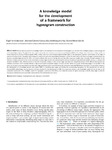Mostrar o rexistro simple do ítem
A knowledge model for the development of a framework for hypnogram construction
| dc.contributor.author | Fernández-Leal, Ángel | |
| dc.contributor.author | Cabrero-Canosa, Mariano | |
| dc.contributor.author | Mosqueira-Rey, E. | |
| dc.contributor.author | Moret-Bonillo, Vicente | |
| dc.date.accessioned | 2017-02-14T17:26:38Z | |
| dc.date.issued | 2017-02-15 | |
| dc.identifier.citation | Ángel Fernández-Leal, Mariano Cabrero-Canosa, Eduardo Mosqueira-Rey, Vicente Moret-Bonillo, A knowledge model for the development of a framework for hypnogram construction, Knowledge-Based Systems, 118 (2017), pp. 140–151 | es_ES |
| dc.identifier.issn | 0950-7051 | |
| dc.identifier.issn | 1872-7409 | |
| dc.identifier.uri | http://hdl.handle.net/2183/18111 | |
| dc.description | The final publication is available via http://dx.doi.org/10.1016/j.knosys.2016.11.016 | es_ES |
| dc.description.abstract | [Abstract] We describe a proposal of a knowledge model for the development of a framework for hypnogram construction from intelligent analysis of pulmonology and electrophysiological signals. Throughout the twentieth century, after the development of electroencephalography (EEG) by Hans Berger, there have been multiple studies on human sleep and its structure. Polysomnography (PSG), a sleep study from several biophysiological variables, gives us the hypnogram, a graphic representation of the stages of sleep as a function of time. This graph, when analyzed in conjunction with other physiological parameters, such as the heart rate or the amount of oxygen in arterial blood, has become a valuable diagnostic tool for different clinical problems that can occur during sleep and that often cause poor quality sleep. Currently, the gold standard for the detection of sleep events and for the correct classification of sleep stages are the rules published by the American Academy of Sleep Medicine (AASM), version 2.2. Based on the standards available to date, different studies on methods of automatic analysis of sleep and its stages have been developed but because of the different development and validation procedures used in existing methods, a rigorous and useful comparative analysis of results and their ability to correctly classify sleep stages is not possible. In this sense, we propose an approach that ensures that sleep stage classification task is not affected by the method for extracting PSG features and events. This approach is based on the development of a knowledge-intensive base system (KBS) for classifying sleep stages and building the corresponding hypnogram. For this development we used the CommonKADS methodology, that has become a de facto standard for the development of KBSs. As a result, we present a new knowledge model that can be used for the subsequent development of an intelligent system for hypnogram construction that allows us to isolate the process of signal processing to identify sleep stages so that the hypnograms obtained become comparable, independently of the signal analysis techniques. | es_ES |
| dc.description.sponsorship | Xunta de Galicia; GRC2014/035 | es_ES |
| dc.description.sponsorship | Ministerio de Economía y Competitividad; TIN2013-40686-P | es_ES |
| dc.language.iso | eng | es_ES |
| dc.publisher | Elsevier BV | es_ES |
| dc.relation.uri | http://www.sciencedirect.com/science/article/pii/S0950705116304737 | es_ES |
| dc.rights | Atribución-NoComercial-SinDerivadas 3.0 España | es_ES |
| dc.rights.uri | http://creativecommons.org/licenses/by-nc-nd/3.0/es/ | * |
| dc.subject | Artificial intelligence | es_ES |
| dc.subject | Knowledge-based system | es_ES |
| dc.subject | Hypnogram | es_ES |
| dc.subject | CommonKADS | es_ES |
| dc.title | A knowledge model for the development of a framework for hypnogram construction | es_ES |
| dc.type | info:eu-repo/semantics/article | es_ES |
| dc.rights.access | info:eu-repo/semantics/embargoedAccess | es_ES |
| dc.date.embargoEndDate | 2019-02-15 | es_ES |
| dc.date.embargoLift | 2019-02-15 | |
| UDC.journalTitle | Knowledge-Based Systems | es_ES |
| UDC.volume | 118 | es_ES |
| UDC.startPage | 140 | es_ES |
| UDC.endPage | 151 | es_ES |
| dc.identifier.doi | 10.1016/j.knosys.2016.11.016 |
Ficheiros no ítem
Este ítem aparece na(s) seguinte(s) colección(s)
-
GI-LIDIA - Artigos [50]






